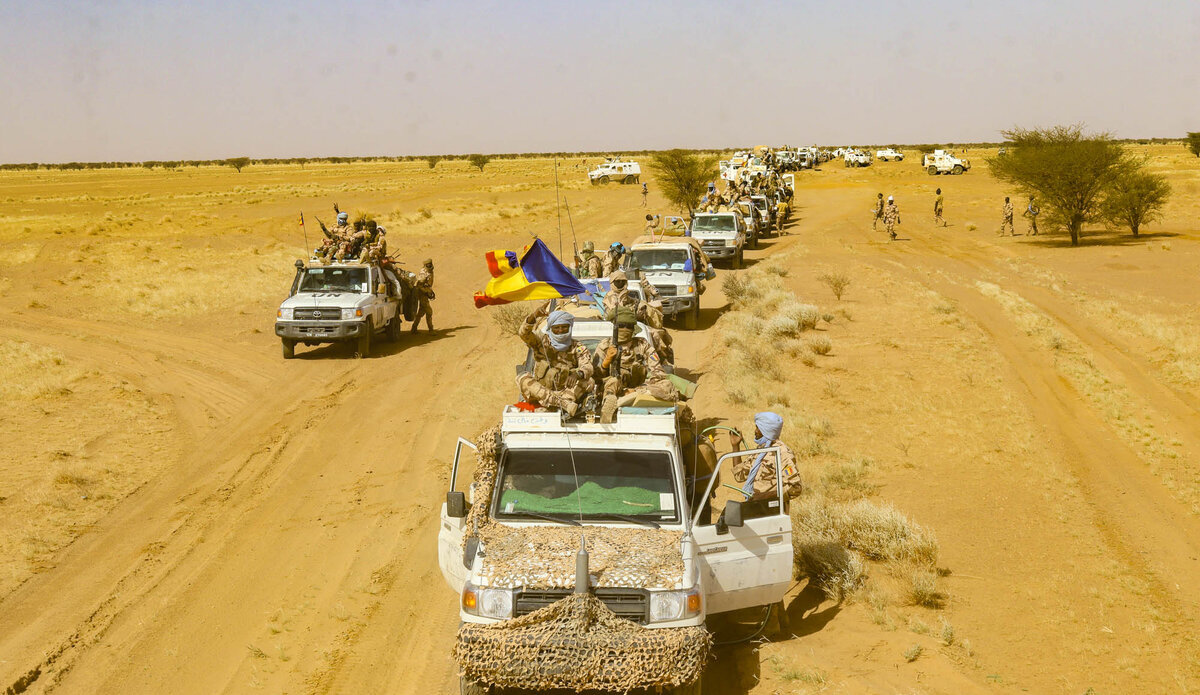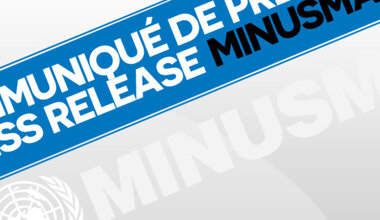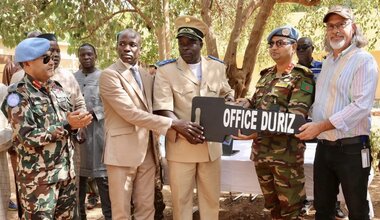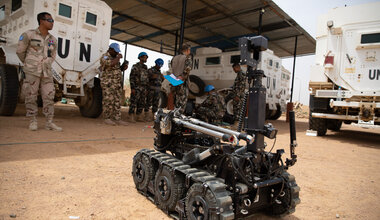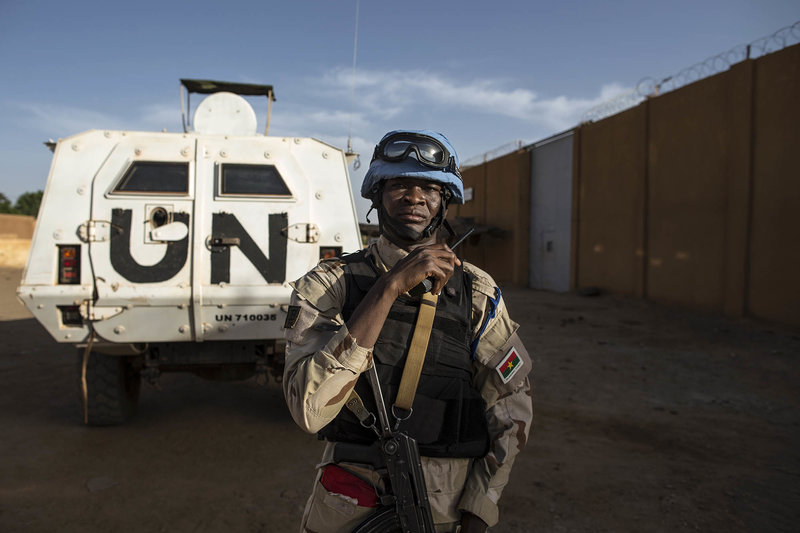Odyssey of the last MINUSMA convoy from Kidal to Gao
On 31 October 2023, the MINUSMA peacekeepers in Kidal, northern Mali, embarked on a final mission that was exceptional in every respect.
On that day, the last MINUSMA convoy in the region set off from its camp in Kidal, on an odyssey of just over 350 kilometers towards Gao. According to Major General Mamadou Gaye, MINUSMA Force Commander, "every kilometer covered was a success, every IED neutralized was a victory, every life preserved was a source of deep relief. We knew it was a high-risk journey, but we had a duty to these peacekeepers who had served with distinction and under the most difficult conditions in northern Mali. They all had to return home safe and sound".

Last high-risk mission
The convoy comprised 848 peacekeepers from Chad, Guinea, Egypt, Nepal, Cambodia and Bangladesh. It included 143 vehicles. What made it even more unusual was that it had no air cover to mitigate the terrorist threat, which is unfortunately omnipresent in these hostile zones. What's more, most of the vehicles were unarmored, further exposing their passengers to constant risk. "We were not only soldiers, but also brothers and sisters on this road of danger. The spirit of camaraderie enabled us to overcome adversity", testified one of the Chadian peacekeepers in the convoy.

But why did MINUSMA take the risk of launching such an operation? The decision was justified by the rapid deterioration of the security situation and the concomitant rise in local tensions, putting the lives of peacekeepers at greater risk every day, in a context marked by a very significant reduction in the Mission's capabilities. In fact, the Mission was no longer in a position to protect its personnel and installations. The operation to extract the Mission's personnel from Kidal was made even more complicated by the lack of sufficient authorization to carry out the air rotations required to transport blue helmets and sensitive equipment. As a result, almost 400 peacekeepers who should have been flown back to Gao were forced to take to the road. Added to this, since the end of September, the logistical convoys that were supposed to reach the Kidal region and repatriate the heavy equipment belonging to the countries contributing troops and police personnel, as well as to the United Nations, have been blocked in Gao.

The decision taken was certainly the lesser evil. A choice had to be made between leaving, to preserve the lives of the peacekeepers, or staying, with the certainty of continuing to expose them to a security situation that had become truly untenable. Another factor also weighed in the balance: the real risk of no longer being able to meet their basic needs, due to the drastic reduction in food reserves and the difficulties of supplying Kidal.
Faced with this Cornelian dilemma, MINUSMA naturally gave priority to preserving the lives of its peacekeepers. "Destroying weapons and ammunition was a difficult decision, albeit in line with UN regulations, but it helped save lives by preventing them from falling into the wrong hands. Our mission was to protect, and we have done so", stressed a peacekeeper.

When the last convoy left the Kidal base on the morning of October 31, the Blue Helmets optimized every available space to embark and dispatch all the brothers and sisters in arms. The convoy was also unable to fill up on rations, water and fuel, due to the limited carrying capacity of its vehicles. "Sometimes, the only thing that motivated us was the hope of returning home safe and sound. It was a test of willpower as well as courage," added another soldier from the Guinean contingent.
Facing the dangers posed by mines with determination

The days when the convoy did not encounter mines were rare. The first explosion occurred on the very day of departure, when the convoy was only 25 km southwest of Kidal. Due to its length (around 9 km), its size, and the constraints of overland mobility (sandy tracks), the convoy could not hope to cover more than around 50 km per day. Fortunately, no peacekeepers were injured in this first incident, but the armored personnel carrier involved was completely damaged, forcing the convoy to abandon it on the spot.
On 1 November, another armored personnel carrier was hit by an IED explosion some 52 kilometers southwest of Kidal. "Each mine explosion was a stark reminder of the reality and volatility of our operating environment. We knew the danger was omnipresent, but we kept going," testified Mahamat, a soldier from the Chadian contingent. Eight peacekeepers were injured, two of them seriously. All were evacuated by helicopter to the MINUSMA military hospital in Gao.
On 3 November, a third armored personnel carrier was hit by another IED while the convoy was 88 kilometers southwest of Kidal, in the Anéfis area. "Every step in this desert had to be taken with extreme caution, every dust that arose could conceal a threat. The mines were our constant shadow, but we advanced in spite of everything, guided by our determination to successfully complete our last mission on Malian soil", stressed a peacekeeper from the Guinean contingent. The seven peacekeepers injured in the incident were evacuated, and the damaged vehicle left behind. At this stage, the equipment was showing obvious signs of fatigue, as were the peacekeepers, who were suffering from a lack of drinking water and food.
Against this backdrop, the convoy was resupplied with water, food and vehicle spare parts on November 6, thanks to two MINUSMA helicopter flights from Gao. The operation was a delicate one, as refueling by air required the prior securing of a landing zone to enable the helicopters to land and deliver the vital goods they were carrying.

Survival and success against all odds
It took eight days of perilous desert travel to reach Gao. The peacekeepers had to overcome all kinds of hardships, including unfavorable weather conditions, as well as having to facilitate complex medical evacuations whenever required, due to the remoteness of the incident points. The convoy suffered a total of six mine explosions, injuring 37 uniformed personnel and damaging seven vehicles. Fortunately, the vast majority of the wounded soldiers have since been discharged from hospital, while the others are in a stable condition and out of danger.
On their arrival in Gao, the peacekeepers were more than exhausted, but they were rightly proud of having accomplished their mission bravely under extremely difficult conditions.

 UN
UN United Nations Peacekeeping
United Nations Peacekeeping
